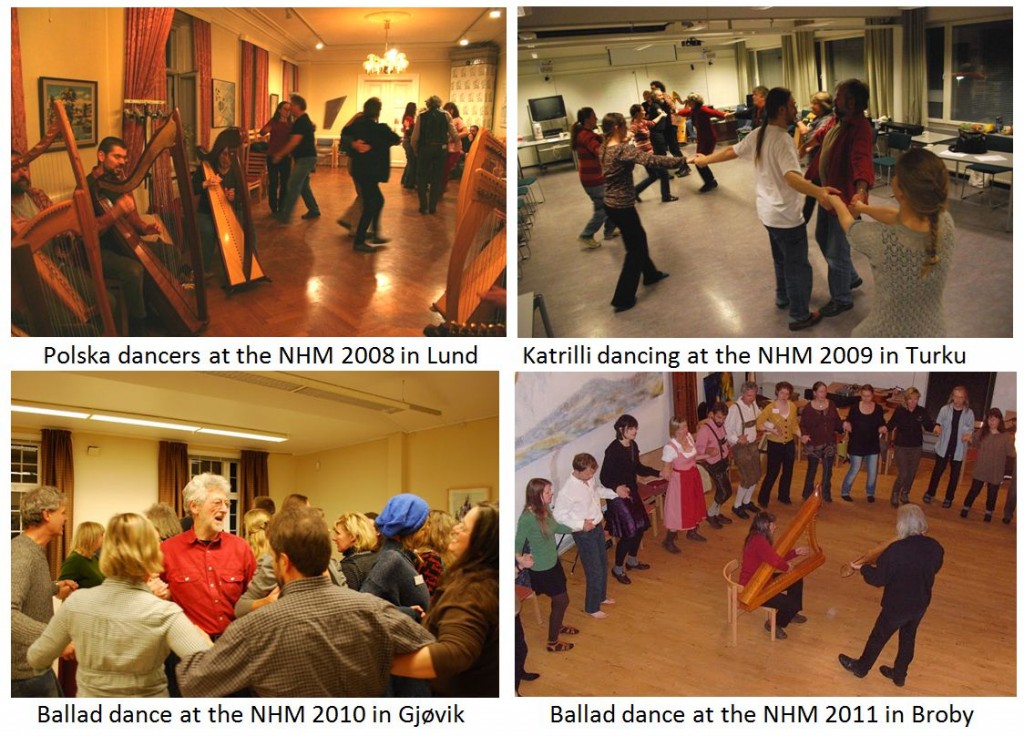- Völuspá 39:
“Sat þar á haugi
ok sló hörpu
gýgjar hirðir,
glaðr Eggþér“
- Atlakviða 31:
“Lifanda gram lagði í garð,
þanns skiðinn vas, skatna mengi,
innan ormum, en einn Gunnarr
heiftmóðr hörpu hendi kníði;
(glumðu strengir, svá golli skal
froekn hringdrifi við fira halda).“
- Rǫgnvaldr Kali Kolsson, Lausavísur 1 (Orkneyinga Saga):
“Tafl emk ǫrr at efla,
íþróttir kank níu,
týnik trauðla rúnum,
tíð erum bók ok smíðir,
skríða kank á skíðum,
skýtk ok rœk, svát nýtir;
hvártveggja kank hyggja,
harpslátt ok bragþáttu.”
- Bósa saga ok Herrauðs, XII.kapítuli:
…”Konungr spyrr nú, hvárt hann kann nokkut fleiri slagi, en hann segir eptir vera nokkura smáleika ok bað fólkit hvílast fyrst. Settust menn nú til drykkju. Sló hann þar Gýgjarslag ok Drömbuð ok Hjarrandahljóð. Því næst kom inn Óðins minni. Þá lauk Sigurðr upp hörpunni. Hún var svá stór, at maðr mátti standa réttr í maganum á henni; hún var öll sem á gull sæi. Þar tók hann upp hvíta glófa gullsaumaða. Hann sló nú þann slag, sem Faldafeykir heitir, ok stukku þá faldarnir af konunum, ok léku þeir fyrir ofan þvertréin. Stukku þá upp konurnar ok allir menninir, ok engi hlutr var þá sá, at kyrr þoldi.“
- Viglundar Saga, 4.kafli:
“Og að enduðum gjöfum lét jarl fram bera eina hörpu. Annar hvor hennar strengur var með gull en annar hvor með silfur. Var þetta smíði hið virðulegasta. Konungur seildist móti og tók að slá en þessi harpa bar svo mikið hljóð að allir undruðust og þóttust eigi fyrr slíkt heyrt hafa.”
- Saxo Grammaticus, Gesta Danorum, Liber XII, 6.1:
“Reversus namque Ericus, cum more regio domi in propatulo cenitaret, inter alios quendam musicae rationis professorem adesse contigit. Qui cum multa super artis suae laudibus disputasset, inter cetera quoque sonorum modis homines in amentiam furoremque pertrahi posse firmabat. Quin etiam tantas fidibus vires inesse dicebat, ut, perceptis earum modulationibus, astantes mente constaturos negaret. Cumque, an eiusmodi usu calleret, interrogatus, peritiam fateretur, tum precibus regis, tum etiam minis effectum praesentare compellitur. Qui cum nec vecordiae metu nec periculi praedictione imperantem avertere potuisset, ne furori nocendi materia suppeteret, primum, aede armis vacuefacta, complures extra auditum citharae in ambitu collocandos curavit, oriente vesaniae strepitu fores irrumpere ereptamque manibus suis citharam capiti illidere iussos, ne ulterior eius modulatio supervenientes quoque mente captos efficeret.(…)”
- Olaus Magnus (1555): Historia de gentibus septentrionalibus. Liber XV, c.4,”De Maialibus festis”:
“… populus omnis vtriusque sexus & aetatis, turmatim in publicis plateis vrbium, at planicie camporum, vbique copiosis accensis ignibus, pro choreis tripudijsque exercendis, concurrere solitus, vetustorum heroum domi forisque magnifica gesta vbilibet in orbe peracta, saltando decantat: etiam quid illustriores foeminae pro aeternis assequendis laudibus, amore servandae pudicitiae perfecerunt. Praeterea quid degeneres ignavique nobiles, crudeles tyranni, & turpes foeminae exclusa honestate fecerunt, patrijs cantionibus & rhytmis sonantibus citharis, ac tibijs alternatim adductis, extoluunt.“
- Rasmus Hanssøn Reravius (1576), about the coronation of Frederik II, King of Denmark in 1559:
““Man maatte og høre det lystige Spil/
Mens Maaltidet vared/ jeg sige og vil/
Med Zitter og Tromper/ med Harper og Gie/
Med konstige og herlige Symphonie/
Basuner og Sincker og Positiv/
Skalmeier/ Trometer og Krumhorn stiv.
Saa sødelig disse her Spil mon gaae/
Det var stor Lyst at høre derpaa.
De siunge saa mangt it Stykke saa fin/
Frantsøsisk/ Italisk/ Spansk/ Latin/
Med Danske oc Tydske ieg siger for sand.
Det er ey mueligt at ieg kand/
Den herlige skat fortelle altsammen/
Som den tid skede med glæde oc gammen.“
- Georg Stiernhielm, congratulation poem for the 17th birthday of Christina, Queen of Sweden, in 1643:
“På Bygden höres roop / och skrijk och skrij af Fröjd
Af glädje höres drön och dön alt vp i högd:
Säckpipor / Trummor / Harpor / Lurar / Nyckelgijgor /
The dricka / dansa / flyggia / flängia /ghlamma / gny /
The quäda / lee / och gantas widh / i hwarian By.“
- Anonymous wedding poem, Väderstad (1697):
“Låt dokk then Musiquant sig intet sinka
Låt honom komma fram
att han må klinka
på Harpan skiön
En lustig Menuet Brudgum til Ära.”
- Fredmans Epistel no.45, Carl Michael Bellman (1740-1795):
“ingen monark
i världen så stark
förmår i sitt land
förbjuda min hand
att på min harpa, pling plingeli pläng,
och det så länge där finnes en sträng,
spela en polska. Pling plingeli pläng.“
- “Guldharpen”, TSB A 50:
Her Villemand gik sig for Strømmen at staa,
– Strengen er af Guld –
saa mesterlig kunde Guldharpen han slaa,
– Saa liflig leged han for sin Jomfru.-
- “Rosilias sorg”, TSB D 115:
Han gav mig en harpa, en harpa av guld
– uti lunden –
han bad jag skulle spela när jag blev sorgefull
– för lekt haver hon med konungasonen den unge –
- “Stolts Gundela”, TSB D 405:
Första slaget hon på gullharpan slog,
Konungens hjärta, det lekte och det log.
– Så stolt var den Gundela.
Ungersven och vi, vi vinna henne aldrig. –Andra slaget hon på gullharpan lät,
Konungens hjärta var nära det grät.Tredje slaget, som på gullharpan klang,
För henne dansade alla konungens hofmän.Fjärde slaget hon på gullharpan månd’ slå,
För henne så dansade båd’ stickor och strå.

